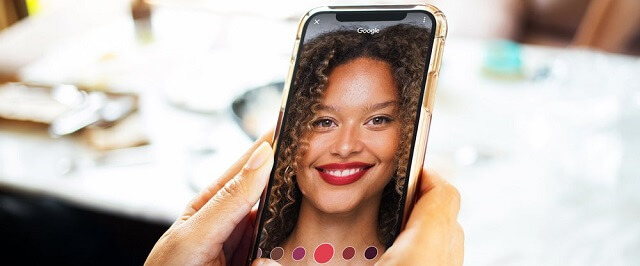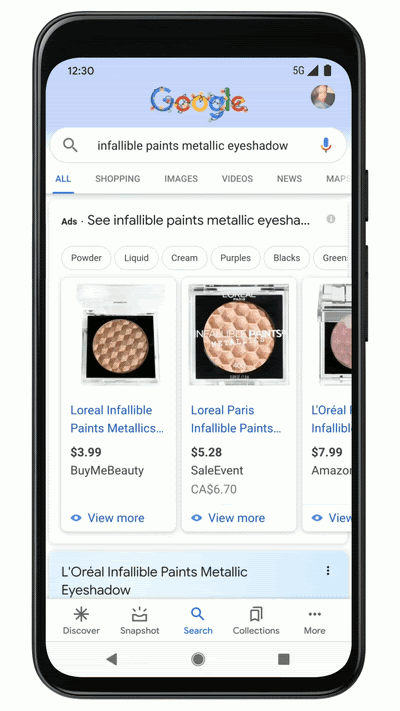Virtual Try-on Makeup: What Google’s New AR Feature Means for Luxury Cosmetic Brands
Without a doubt, the pandemic has accelerated eCommerce, boosting online sales globally as a result of the closure of thousands of nonessential retail stores. As businesses continue to recover from the hardship of 2020, maintaining a business model for a socially distant world is still more crucial than ever, with consumers feeling more confident than ever to make online purchases. However, though many benefits come with online shopping, there has been one hindrance for the cosmetics industry. This obstacle has been the ability for consumers to try on products. Google’s new AR makeup try-on feature is changing this, allowing brands the opportunity to provide virtual makeup experiences for their customers.
E-commerce brands now having a platform such as Google Shopping and the Google App to provide an immersive makeup experience for customers will be an enormous advantage to capture both the home and in-store shopper, as brick-and-mortar begin to reopen.

Image Source
AR ‘Try-On’ Features to Fulfil ‘Real Life’ Needs.
Google’s AR beauty try-on feature budded amid the pandemic, with the company acknowledging consumers still crave in-store experiences, particularly when it comes to beauty. Knowing which foundation, lipstick and eyeshadow to choose for your skin tone can be a tricky process little own when shopping online without the ability to try the product first. Bringing the benefits of in-store shopping to the consumer in the safety of their home will help the cosmetics industry to thrive, rather than suffer, during times of disruption. Now that consumers can begin to try virtual makeup from various brands with the Google Try-On Ads feature, it will help businesses gain more trust, authority and conversion with online sales.
Formerly a part of Google’s in-house incubator team, Area 120, the team at Shoploop worked on this feature with Google to consolidate the user journey that often occurs. For example, a person might see a makeup product on social media and then want to see the product review on YouTube, then after these steps they finally visit the makeup brand’s eCommerce to make the purchase. Shoploop is an all-encompassing video shopping platform for discovering, evaluating and buying products, all in one place.
How Google’s ‘Try -On’ Feature Works.
Consumers can use Google’s makeup try-on feature either by going onto the Google Shopping browser or via the Google App. While browsing these platforms, when a product catches the consumers attention, they can swipe through images of the makeup product shade on different skin tones to get a perfect colour match. They can tap the ‘try on’ button option to try the colour shade on for themselves. Leveraging this AR try-on feature will be a competitive advantage, especially now while businesses only begin to catch onto the trend.
In addition to the try-on feature, consumers can watch product recommendation videos, with industry experts and beauty enthusiasts demonstrating and reviewing the products.

How Is Google’s Try-On Feature Different From YouTube’s Try-On Feature?
YouTube is flooded with makeup tutorials. So, it made sense when it launched its ‘AR Beauty Try-On’ feature on the YouTube app. But what is the difference between Google and YouTube’s try-on features? YouTube’s feature is used by influencers who collaborate with brands to create makeup tutorial videos with paid sponsorship. When a viewer is watching the tutorial, there is a split-screen option where they can begin to try on different colour shades of the products that are being promoted in the tutorial by the influencer.
The try-on feature for YouTube is more of an AR-powered ad campaign. Whereas the Google try-on feature is more of a tool that can be directly utilised by brands for on-site eCommerce conversion, creating a streamlined user journey for consumers.
Opportunity for Luxury Commerce Brands
With many brands already leveraging these AR try-on features like cosmetic brands MAC and NARS, virtual reality e-commerce is an excellent component to incorporate into a digital strategy, particularly for luxury commerce brands. This way, brands can remain competitive and build authority and reputation within the industry. The Google try-on platform also includes recommendations from experts and beauty enthusiasts, so taking advantage of these additional features will boost brand affinity with an audience while providing a satisfying user experience.
Final Thoughts
While consumers may miss the feeling of an in-store experience and trying on products while chatting with the assistant, they are beginning to acknowledge the benefits of shopping online. It’s safe, fast, secure and with the vast number of brands now competing online, there are bountiful promotions and incentives for consumers to shop with particular brands. Luxury commerce brands within the cosmetics industry must keep up with e-commerce trends like implementing Google’s new AR try-on feature in order to remain relevant in the digital landscape. Fulfilling the consumers’ desire for a ‘real-life’ experience will be key to generating traffic and conversions in 2021 and beyond.
Subscribe To Us
Our Services
Categories
Subscribe To Us
Contributors
Categories

This website uses cookies so that we can provide you with the best user experience possible. Cookie information is stored in your browser and performs functions such as recognising you when you return to our website and helping our team to understand which sections of the website you find most interesting and useful. Third party cookies such as Google Analytics is also used on this site to provide analytics in order to better understand the user engagement on our site.
You can adjust all of your cookie settings by navigating the tabs on the left hand side.
Strictly Necessary Cookie should be enabled at all times so that we can save your preferences for cookie settings.
If you disable this cookie, we will not be able to save your preferences. This means that every time you visit this website you will need to enable or disable cookies again.







0.Comments